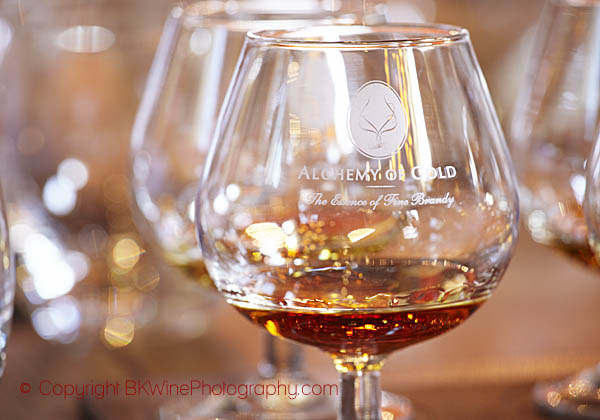Calvados – The apple fruit brandy from Normandy
Text: David Furer
Photo: Per Karlsson, BKWine
Copyright David Furer & BKWine, December 2008
An abbreviated version of this appeared in the US’ Sante magazine, www.isantemagazine.com.
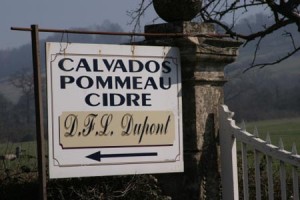
Autumn harvest brings its bounty not only to the winemaker and chef but also to the oft-overlooked cider and fruit distillate producer. Foremost amongst those producing fine fruit spirits are the pomoculteurs of France’s Normandy region, those of the noble Calvados.
When Romans arrived in northern France two millennia ago they found the locals drinking not water but a rough cider from wild apples. According to records from the time it tasted awful but was preferable to falling ill from tainted water supplies. Distillation here likely dates to monks’ usage of it for medicinal preparations as far back as the 7th century but it wasn’t until the 16th century when the Normans brought Spanish varieties from Asturias, grafting them upon the local rootstocks, that cider became a product to be savored and then distilled into its essence.
Apples and pears
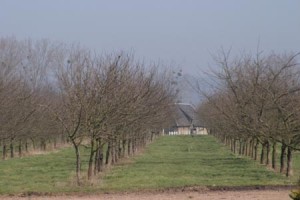
Today, there are no fewer than 250 apple varieties within Calvados’ heartland of Pays d’Auge. Twenty years ago there were an average of 5% of pears there, the amount which is still allowed although less is currently used in Pays d’Auge Calvados AC.
In all there are 9 million trees planted to both the traditional high-stem and the modern low-stem types for the region’s 10,000 licensed producers. The average lifespan of a productive apple tree is 30 years, although some live far longer, with pear trees living as long as 300 years.
The presence of pear trees helps to lower the ambient humidity of the air for apple trees planted nearby. In former times there was approximately 10% of pear used both in the production of cider and Calvados.
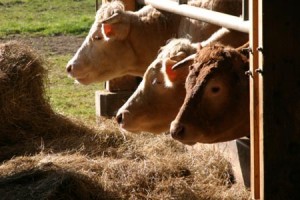
The pastoral farming nature of this area necessitates that Calvados producers choose how they raise their apples and pears. Producer Etienne Dupont pointed out that the proximity of animals to trees is unhealthy as, “the yeasts associated with animals will outperform those of plants.” This may account for the random character of ‘barnyard’ aromas in some Calvados and an AC minimum of volatile acidity required in all base ciders used for Calvados production which Dupont thinks should be abolished.
Distilling the essence
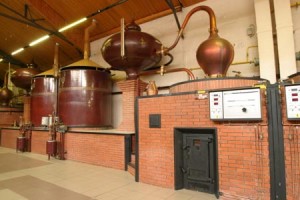
AOC status was granted in 1942 to protect the region from war requisitions; the western Domfrontais district was given separate AC status in 1997. The first distillation of cider yields an intermediate product with a strength of approximately 30% from which the heads and tails are eliminated. These ‘petites eaux’ are then heated for a second distillation.
As it emerges from the still Calvados is colorless, produces a burning sensation on the palate, and gives off aromas of fruit and alcohol. Whether continuous- or double-distilled all raw spirit here must be 69-72% abv before being placed in wood for aging.
Caramel and sugar are both allowed and the ‘angel’s share’ varies between .08-4% annually.
In quality leader Christian Drouin’s opinion, “there’s no bad Calvados these days. Commercial, yes, but nothing unpalatable.” As with all great brown spirits, complexity from Calvados is primarily derived from the interaction of the oxidation of spirit esters with wood elements. There are an estimated 250 possible aromas associated with Calvados and, “if fortunate,” Drouin said, “a good sommelier will distinguish five or six.”
Calvados producers
The big boys
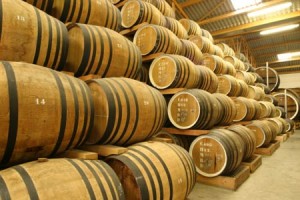
Thought relatively isolated from the rest of France Calvados distilleries haven’t been immune to industry changes. October 2007 heralded Calvados leader Pere Magloire’s majority acquisition by the Swiss Spirit Capital for its Russian clients which, as owners of Calvados Boulard and Lecompte, gives it enterprises in each of the three Calvados AC. The lovely Chateau du Breuil’s current ownership is the Swiss holding company DIWISA, also operating for Russian investors.
The locally-owned Busnel distillery has a daunting nine chais. My visit was memorable for the creaking pot still working late into Friday night. The ripe apples are initially washed with river water, then again with filtered city water. Busnel uses caramel and sugar to ameliorate all its products, making for consistency over character. All wood here is used, so alcohol is more present in their products. “We defend this difference,” according to Philippe Terlier, the director of the distillery. Busnel’s sales are 4.5 million hectoliters, accounting for 25% of all Calvados. Along with its broad US sales Busnel sells the lion’s share of Calvados in the UK via supermarkets’ own-brands.
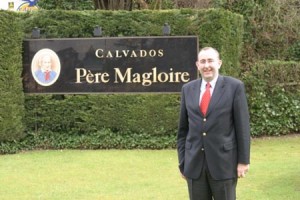
Pere Magloire exports 60% of its production though leaving the work of promotions to its importers. They assert that Calvados isn’t fashionable in France but has enjoyed an uplift in sales in Scandinavia and Russia. PM sometimes uses caramel for amelioration but isn’t systematic about its use. Its facilities receive 25,000 visitors per year in its quiet countryside facility. Once ubiquitously positioned in many markets, Pere Magloire has slipped in recent years due to both mixed management performance and unpredictable market forces.
Stately 16th century Chateau du Breuil rests behind its 18th century distillery building which has housed textile, cheese, and chocolate production until finally being converted into Calvados production in 1954. Its two computer-controlled double stills source cooling water from the River Touques running below the distillery. 40,000 visitors each year visit its very attractive grounds along the main Pays d’Auge north-south road make it the region’s top distillery attraction by far.
Below the chateau itself is one of three chais housed within its grounds. While vintage Calvados is made, du Breuil focuses upon blends, exporting 55% of its easily distinguished bell-shape and elongated neck bottles to Germany, Belgium, Russia, UK, USA, and elsewhere. The very low and the higher end products are good albeit treated with a touch of caramel and sugar while the middle-tier bottlings suffer from an overuse of caramel and sugar and are very dull.
Keeping it small
Coeur du Lion
When his father purchased a house for relaxation which, for tax purposes, had an attached farm with thousands of cider-producing apple trees Christian Drouin’s future was determined. Once living comfortably in Montreal with his wife and a well-paid job in economics, he was summoned back home to assist his father in what turned out to be an overwhelming new venture.
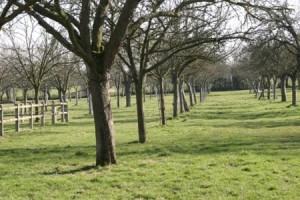
After two years of countless rebuffs trying to sell his cider and Coeur du Lion Calvados in Normandy, Christian lit upon the idea of going strictly to Michelin-starred restaurants, those for whom quality was the only stipulation and who had no loyalty to any one producer. The multi-lingual ‘intellect of Calvados’, as his colleagues quickly named him, was soon to open unheard-of markets for this unique artisan spirit. “I work hard in areas where my colleagues aren’t interested,” he observed, “perhaps because it’s just easier.” His son Guillaume, a Montpellier-trained winemaker, is actively engaged in the Calvados business showing no interest in wine now other than drinking it.
Drouin uses a traditional square hydraulic press for the pressing of the thirty varieties of apples. The selection is typical of the Pays d’Auge–60% are selected for sweet- or bittersweet-ness, 10% for tartness, and 40% for tannin structure and aromatics. Two year old oak barrels are filled with cider first to integrate any remaining wine characteristics, then distilled itself, before being filled with further distillate.
On the premises is a traditional 1940s mobile still which they use for their distilling needs. As with other quality-minded producers Drouin adds neither caramel nor sugar. The company’s Pays d’Auge hq is augmented by the Domfrontais’ Lauriston distillery, an AC Drouin was instrumental in helping to establish, producing a whopping 80% of that AC with image-leader Lemorton leading the UK and France markets.
Dupont
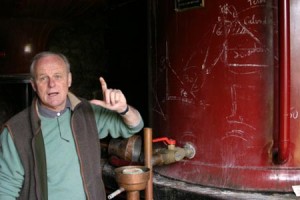
Etienne Dupont and his son Jerome inherited the dairy and apple farm they now inhabit from ancestors who before them only sold Calvados to the big companies which ended up in anonymous blends. Upon terminating his banking career in 1980, Etienne decided to specialize in commercializing the family cider and Calvados by first training a month at Courvoisier under its then master distiller, now managing director, Jean-Marc Olivier. “Thanks to them I learned a lot about the quality of cider to distil. When I have problems now I still go to them.”
The Dupont relatively light and elegant house style reflects the Courvoisier influence. Under blue skies he exclaimed, “it’s better to be a farmer today than a banker playing with sub-prime numbers!” Dupont owns 15,000 low-grafted, low-yielding trees on 66 acres accounting for 95% of his needs; ten varieties are “still too many but it’s not easy to change. In the old days farming was strictly producing milk and apples. Farmers planted different varieties in order to harvest ripened fruit in separate periods throughout September-November. If you want to get something with body and consistency you have to carefully select the apple types.”
Dupont is also one of the few producers experimenting with organically-labelled products, saying, “there’s a demand for organic cider but not organic Calvados.” While many producers use local water to soften their raw Calvados, oddly enough Dupont prefers the bottled Volvic.
Huet
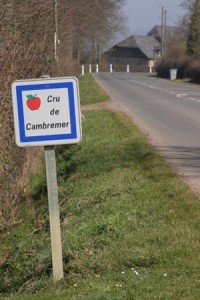
With a plethora of birds squawking about for show, Pierre Huet’s 66 acres of orchards, containing a wealth of 40 varieties, provide their total needs. The current generation of Huets, Philippe and nephews Francois and Cyril, eschew the addition caramel or sugar and source their barrels locally at this Cambremer distillery. Stubbornly traditional, Huet’s products are artisan without being costly.
Camut
One of the great characters in Calvados is the affable Emmanuel Camut who lives in the 1780 home once belonging to the man for which his brand is named, his great-grandfather Adrien Camut. Emmanuel shares work with brothers Jean-Michel and Jean-Gabriel along with a full-time administrator.
With the sound of songbirds chirping, we became acquainted over Sunday morning billiards and tea. “Aside from harvesting with a machine we make Calvados exactly the same way my grandfather did. We don’t filter, don’t use caramel or sugar.” He blends all bottlings as it’s, “not good for the Calvados and only helps for marketing. Blending assists the equilibrium.”
Unusual in the region, the Camuts have their own nursery and apiary. Emmanuel is the archetypical disorganized artist as exemplified by his cobweb-filled chais.
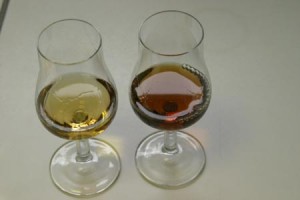
How does he see the future of Calvados? “The style now is developing more influence from wood and sugar. My grandfather thought that we’re lucky to have the taste of apple and not to effect it with wood.” He depends upon a hundred large, neutral barrels to give as little oak character as possible with the Camut style further defined by the adapted, patented alembic which employs a partial re-distillation of the initial spirit and cooling of the vapor by the addition of water around the condenser coils.
Half of his 15, 000 bottle production is exported and Emmanuel isn’t interested in expanding production. ‘We’ve everything we need here, good lives and nice homes and nice cars, what do we need for more money?”
Roger Groult
Jean-Roger Groult is the fourth and current generation of this relatively recent Calvados company Roger Groult. Established in 1975, the Groult family first found fame before the turn of the 19th century with its first distiller, Pierre’s, award-winning spirit.
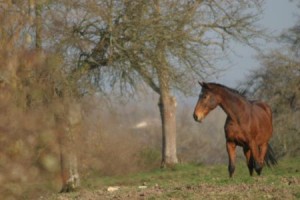
Groult uses no sugar but a bit of caramel adding that, “it will cease this year.” The Groults grow only half of their annual need of 500-600 tons of apples with the remaining coming from neighboring growers. As with many Calvados producers spent apple pressings are given to local farmers for cattle feed. Groult’s highly-organized cellars of very old barrels form a a well-integrated contrast between the traditional and the modern.
“Calvados is starting to be known in many countries. However, while people tell me they enjoy it they don’t necessarily buy it as often as this would imply,” admits the youthful and optimistic Groult. “Our exports are increasing, now accounting for 55% of total sales, and we’re able to grow further still.”
– – –
“The” book about Calvados
CALVADOS, the world’s premier apple brandy
By Henrik Mattsson with Olle Mattsson
The most exhaustive work dedicated to this noblest of non-grape fruit spirits was self-published in 2005 by Swedish wine writer Henrik Mattsson and his father Olle. An exhaustive list of quality producers and a touring guide to the region make this useful for both the aficionado and professional alike. This is essential reading for the drinks pro and a curious addition to the library of spirits enthusiasts everywhere. It may be ordered at www.calvadosbook.com.
Appellations
- Calvados
Distillation not proscribed but usually continuous. A mix of chalky, sandy, and rocky soils.
- Calvados Pays d’Auge
Grown on deep Jurassic clay-limestone soils and double-distilled. Pears planted here are traditionally planted to break the strong Channel winds rather than primarily for Calvados.
- Calvados Domfrontais
Thin, granite soils more suitable to pears and so must be a minimum of 30% pears in the must; continuous distillation.
Calvados Styles
(Excerpt from the book Calvados by Henrik Mattsson)
- Fine/Trois Etoiles/***/Trois Pommes
Aged a minimum of 2 years in oak.
- Vieux/Reserve
Aged a minimum of 3 years in oak.
- V.O./VO/Vielle Reserve/VSOP/V.S.O.P.
Aged a minimum of 4 years in oak.
- Extra/X.O./XO/Napoleon/Hors d’Age/Age Inconnu
Aged a minimum of 6 years in oak.
- Year/Mis en Bouteille en xxxx
Vintage year corresponding to the year of distillation, not the harvest year.
DAVID FURER discovered his passion for wine not in his native California but in 1991 while travelling in what is now his host country of England. He’s the author of Wine Places (Mitchell Beazley, 2005), a contributor to the annual guide Wine Report (Dorling Kindersley), Hugh Johnson’s Pocket Wine Book and the Which? Wine Guide; a writer for numerous magazines throughout the world. He’s led wine classes and guest lectured at the University of Chicago, Oxford and Cambridge universities, at Volkshochschulen in Germany, and California’s Professional Culinary Institute. David is a Certified Wine Educator and Advanced Sommelier.
© Copyright David Furer & BKWine, 2008



